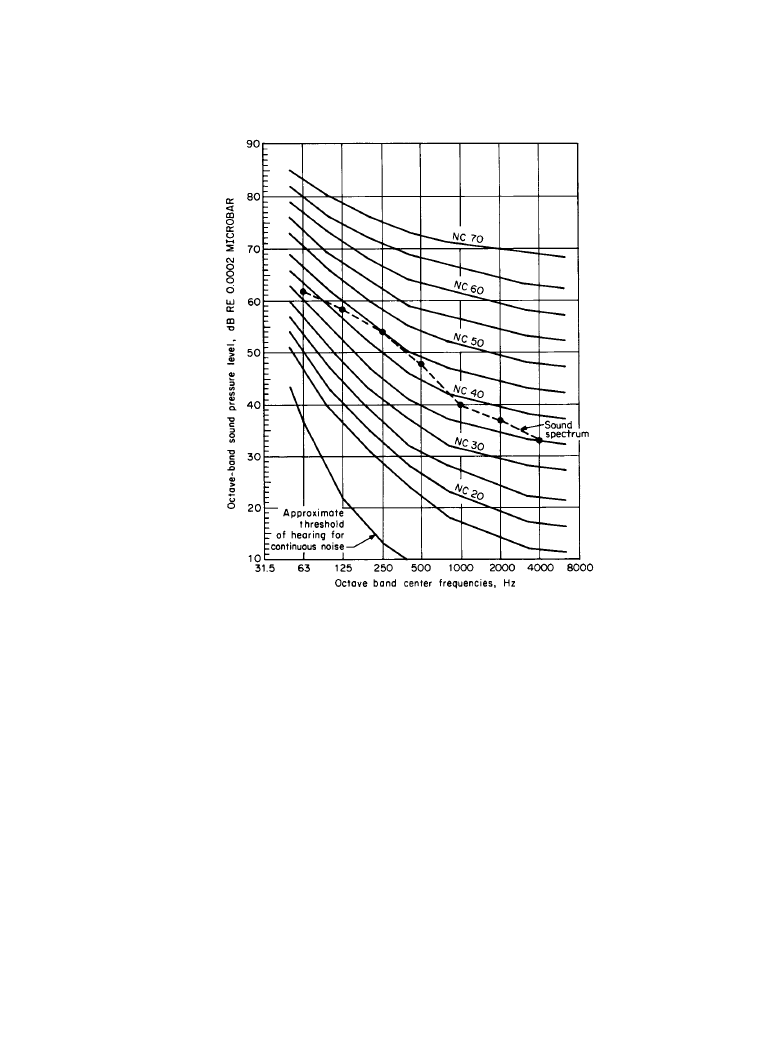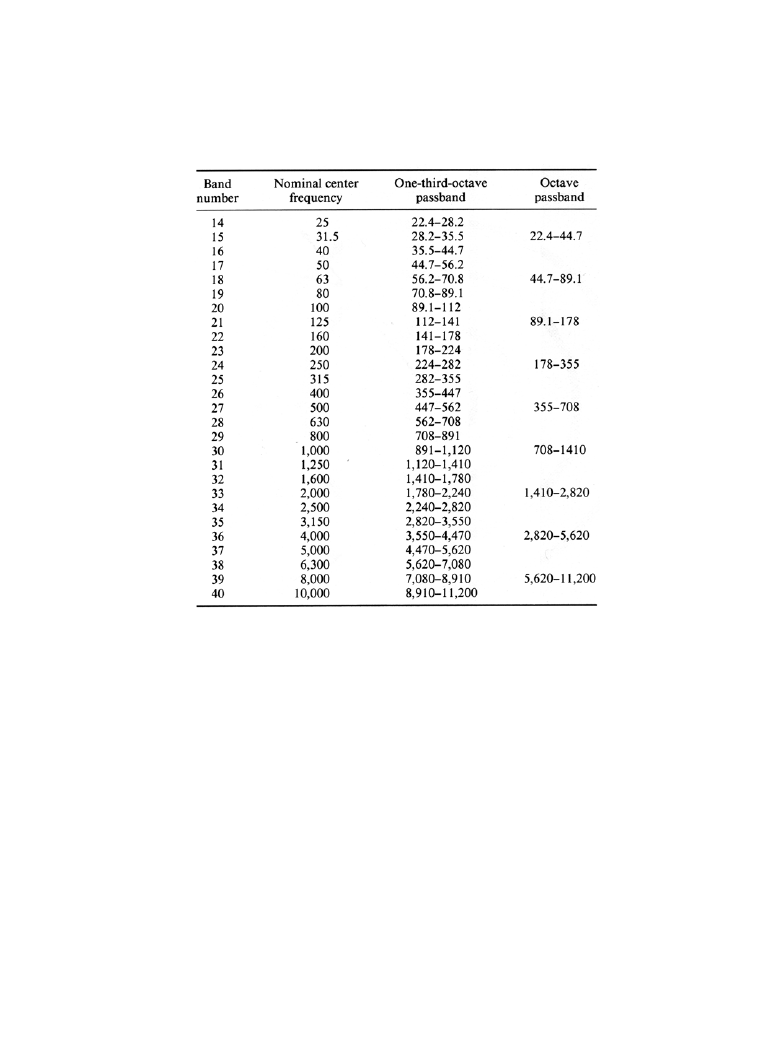ВУЗ: Казахская Национальная Академия Искусств им. Т. Жургенова
Категория: Книга
Дисциплина: Не указана
Добавлен: 03.02.2019
Просмотров: 21616
Скачиваний: 19

Criteria for Acceptability of Acoustical Performance 3-25
In some circumstances quieter is not necessarily better, for reducing noise levels may reveal
other sounds that were previously hidden. Noise levels can often be increased to the NC value
specified in Table 3.2.1 without causing noticeable intrusion. This masking of an intruding
sound may be less expensive than controlling the sound itself.
It may be necessary to set special criteria for a particular activity. For example, for a recording
studio, noise criteria may be set equal to the noise floor of the recording instrumentation. This
level may be above the aural threshold of the performers, with the result that it is possible to
Table 3.2.1 Design Goals for Mechanical-System Noise Levels.
Downloaded from Digital Engineering Library @ McGraw-Hill (www.digitalengineeringlibrary.com)
Copyright © 2004 The McGraw-Hill Companies. All rights reserved.
Any use is subject to the Terms of Use as given at the website.
Criteria for Acceptability of Acoustical Performance

3-26 Architectural Acoustic Principles and Design Techniques
identify clearly a source of intruding noise before a recording session begins and yet not have the
offending noise be audible on tape.
3.2.1c
Maximum Levels
The maximum noise expected in a space has to be determined. For example, if a space is used
primarily for dining at low sound levels but if it is anticipated that the space will also be used
occasionally as a nightclub when a group will bring in large loudspeaker stacks, an estimate of
these higher sound levels must be made so that intrusion into adjacent spaces can be calculated.
The activities in an adjacent rehearsal room may be curtailed if the dining-room sound levels are
40 dB higher.
Figure 3.2.2
Noise-criterion (NC) curves. (From [4]. Used with permission.)
Downloaded from Digital Engineering Library @ McGraw-Hill (www.digitalengineeringlibrary.com)
Copyright © 2004 The McGraw-Hill Companies. All rights reserved.
Any use is subject to the Terms of Use as given at the website.
Criteria for Acceptability of Acoustical Performance

Criteria for Acceptability of Acoustical Performance 3-27
3.2.1d
Interference of Speech Communication
Mechanical equipment, air-distribution louvers, and other sources of sound may generate noise
that causes speech to be unintelligible. Thus person-to-person conversations and telephone con-
versations rapidly become exhausting, and the efficient functioning of an administrative office
can be thoroughly impaired. Criteria for adequate speech intelligibility can be developed accord-
ing to [1 and 2].
3.2.1e
Exterior Noise
Concern need be given not only to sound levels within the space but also to those outside in the
neighborhood. The community may have a specific bylaw limiting noise levels. If not, the crite-
ria for maximum noise levels should be based upon available annoyance data. It is appropriate to
establish these criteria up front in a permit application rather than hope that abutters will not stir
up community objections at a later time.
3.2.2
Mechanical Systems
Mechanical systems are the source of ventilation for recording studios, control rooms, and asso-
ciated spaces. The acoustical concerns generally are mechanical systems as a source of noise
produced by such items as fans and airflow, and as a path for sound transmission between spaces
as through ductwork. A more complete treatment of the mechanical system as a source of noise
may be found [3].
3.2.2a
Sound Generation by Fans
Fans that are required to move air through a ventilation system inherently generate noise. Many
factors determine the amount of noise produced, including the type of fan used, the volume of air
to be delivered, the static pressure against which the fan is forcing the air, the blade passage, and
the efficiency of the fan system.
The most common type of fan used for ventilation systems is the centrifugal airfoil fan,
although other types of system are not unusual. Each system tends to produce its own character-
istic spectrum of frequency, but in general fans used for ventilation systems tend to produce
more low-frequency noise energy than high-frequency noise energy. In most cases, these fans are
contained within a prefabricated housing which in turn is connected to the supply-air ductwork
system and to the return-air ductwork system. It is important to note that the sound generated by
a fan propagates as easily through the return-air system as through the supply-air system because
the speed of sound is so much faster than the speed of the air within the ductwork.
The sound power level generated by a fan may be calculated by the following
(3.2.1)
Where:
L
w
= sound power level of fan, dB
K
w
= specific sound-power-level factor for type of fan, dB
L
w
K
w
10 log q
( ) 20 log p
( ) K
+
+
+
=
Downloaded from Digital Engineering Library @ McGraw-Hill (www.digitalengineeringlibrary.com)
Copyright © 2004 The McGraw-Hill Companies. All rights reserved.
Any use is subject to the Terms of Use as given at the website.
Criteria for Acceptability of Acoustical Performance

3-28 Architectural Acoustic Principles and Design Techniques
q = volume flow rate, ft
3
/min (m
3
/s)
p = static pressure, in of water (kPa)
K = 0 (metric K = 45)
K
w
for centrifugal airflow types of fans tends to arrange itself in a smooth spectrum with val-
ues of approximately 35 to 40 dB in the 63-Hz octave band and transitioning down to 10 to 15 dB
in the 8000-Hz band. It should be noted from Equation (3.2.1) that a doubling of the volume flow
will add 3 dB of sound power level, whereas a doubling of pressure will add 6 dB to the sound
power level. Therefore, it is important to design a ventilation system with adequately sized duct-
work and with smooth transitions and bends to keep the static pressure as low as possible.
An additional pure-tone component to the noise, blade-frequency increment (BFI), is gener-
ated by each fan blade passing by an edge or obstruction, such as the discharge opening of the
fan unit. The octave band in which it falls is determined by calculating the blade-passage fre-
quency and referring to Table 3.2.2.
(3.2.2)
Most fan systems are of a design that gives a BFI of 3 to 10 dB in the 125- or 250-Hz band.
The result is that unless this BFI is adequately attenuated, the audible pure tone will be in the
same range of frequency as the fundamentals of speech and many musical instruments.
Fans should be selected for a maximum efficiency rating. A decrease in efficiency results ill
an increase in the sound power level generated. Most systems operate at a reduced efficiency
which adds approximately 5 dB to the fan power level, and poorly selected or improperly main-
tained fans have been known to add as much as 20 to 25 dB to the fan power level.
Noise generated by the fan not only travels down the supply and return ductwork systems but
also is radiated off the fan housing. In general, the fan housing is a very poor isolator of sound
and for most practical purposes, especially in lower frequencies, can be considered to provide no
isolation whatsoever. Therefore, it is good practice to locate the fan assembly well removed from
the recording studio and control room.
Most reputable fan-system manufacturers provide octave-band sound-power-level data for
their systems. These numbers are obviously preferable to the generic methods of calculations
described here. In addition, other devices within the mechanical system may incorporate smaller
fans, such as fan-powered terminal boxes. These smaller devices are generally located in the
ductwork closer to the specific rooms to be ventilated, providing an extra boost to the airflow as
required by the system. The accuracy of these generic methods of calculation tends to decrease
as the size of the fan decreases, but the octave-band sound power level of these smaller devices is
also generally available through the manufacturer.
3.2.2b
Turbulent Noise in Ducts
Airflow noise is generated by turbulence within the ductwork and at diffusers and dampers. Air
turbulence and, therefore, airflow noise generally increase as the speed of airflow increases.
Therefore, it is good practice to keep the speed of airflow low. Several rules for controlling air-
flow noise are:
Blade-passage frequency
r/min
number of fan blades/60
×
=
Downloaded from Digital Engineering Library @ McGraw-Hill (www.digitalengineeringlibrary.com)
Copyright © 2004 The McGraw-Hill Companies. All rights reserved.
Any use is subject to the Terms of Use as given at the website.
Criteria for Acceptability of Acoustical Performance

Criteria for Acceptability of Acoustical Performance 3-29
•
Size ductwork so that the flow of air stays below 2000 ft/min and preferably below 1500 ft/
min. The velocity of air in a duct may be calculated by dividing total cubic feet per minute in
that duct by the cross-sectional area in square feet of the duct itself.
•
Airflow velocities through diffusers should be kept below a maximum of 500 ft/min through
all diffusers. For critical applications, lower speeds such as 200 to 300 ft/min are advisable.
•
Air valves and dampers should be located so that the airflow noise that they generate does not
contribute to the noise ducted from upstream sources.
•
Splits and bends in the ductwork should be smooth. Abrupt corners and bends should be
avoided, especially near the fan, near high-airflow-ve1ocity locations, and near diffusers and
grilles.
Airflow noise is typically a major component of mid- and high-frequency background noise
in recording studios. However, when there are abrupt bends and turns in ductwork systems, espe-
cially with high airflow velocity, a considerable amount of low-frequency energy may be gener-
ated that is extremely difficult to control.
Table 3.2.2 Limits of Frequency Passbands
Downloaded from Digital Engineering Library @ McGraw-Hill (www.digitalengineeringlibrary.com)
Copyright © 2004 The McGraw-Hill Companies. All rights reserved.
Any use is subject to the Terms of Use as given at the website.
Criteria for Acceptability of Acoustical Performance